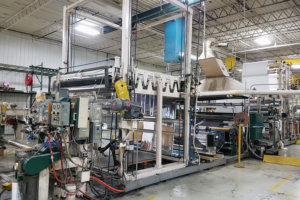The Hot Melt Coater: An Introduction

Don’t worry: no matter what you decide to do, CTI has you covered. Let’s walk through an introduction to hot melt coaters, and determine whether or not this machinery—and this technique—could be in your future.
What is a hot melt coater?
Let’s explore the hot melt coating machine, otherwise known as a hot melt coater. Ultimately, a hot melt coater may function in several different ways, which we’ll explore below. Therefore, those machines may vary depending on the method utilized. A hot melt coater that utilizes knife-over-roll coating, for example, must incorporate a blade into its overall structure. Not only does the hot melt coater apply the coating, it’s also responsible for slicing it or rolling it after the application process.
Of course, you might want to keep in mind that, as important as hot melt coaters are, you don’t necessarily have to invest in a machine permanently. In fact, investing in equipment you’ll only use for the short term or part of the time could mean wasting money. Investing in equipment also means maintaining that equipment, and hiring trained employees, or training existing employees.
All of these reasons lead many business owners to work with third party manufacturers. This enables them to outsource manufacturing, resulting in a more consistently and efficiently made product. You get a better result, while spending less time and money. Although working with a third party isn’t for everyone, if you vet a company properly before committing, you can find an option that works for you.
What are hot melt coating methods?
Hot melt coating methods involve applying a substrate to a surface through melting beforehand. Once the substrate is “pre-melted”, it’s applied and cools on top of the surface, taking on the desired shape and appearance. You’ll typically see it used in the pharmaceutical industry, as well as industries reliant on adhesives and labels.
As you utilize a hot melt coater, you’ll achieve low to moderate viscosity levels through the melting process. The reason why we prefer low to moderate viscosity during the coating process in general is that, in order to maintain uniformity, we have to be careful about the thickness of the coating—and it’s much easier to control those thickness levels with low to moderate viscosity. The melting process really enhances that control. Alternatives might involve water or solvents. When you don’t have to worry about those aspects, however, the process is much faster.
Keep in mind that different types of hot melt coating methods exist, all servicing different purposes. Some of the most popular types of hot melt coating methods today include:
- Gravure coating, in which we apply resin to engraved rolls.
- Slot die coating, in which we apply a slurry of coating or thin film onto flat surfaces.
- Roll coating, in which we utilize three rollers to apply the coating.
- Knife-over-roll coating, in which we use a knife blade to control the thickness of the coating.
- Spray coating, in which we apply thin metallic and non-metallic materials in a liquid form.
What are the three types of coating?
There are different types of hot melt adhesives to consider, of course. These adhesives involve not only different components, but different effects.
Among them are:
- Ethylene vinyl acetate, which is a copolymer adhesive. This adhesive you’ll find most often in different types of paper and cardboard. Therefore, it’s frequently utilized in assembly industries. It can adhere to steel aluminum, many types of plastics, and rubber. The only problem with these EVA coatings is that they typically aren’t very heat resistant.
- Polyolefins, which we use for shrink wrap, as well as food and electronic packaging, as well as plastic toys and manufacturing materials. You’ll even find it woven into certain fabrics for clothing.
- Polyamide-based hot melts. Unlike EVAs, these hot melts have high melting points and thermal stability. They also have a strong degree of chemical resistance to oils, plasticizer, and common solvents.
Use Our Hot Melt Coater
Clearly, there are many reasons why we use hot melt coaters in the first place. As previously mentioned, you don’t necessarily have to buy hot melt coater machinery outright in order to execute the manufacturing processes you need. Third-party manufacturers are at your disposal—you just need to find the right one.
When working with a company like CTI, you don’t have to make assumptions about how we make a product. We’ll walk you through the process from beginning to end, and for that matter produce a prototype before you’re fully committed. Additionally, you can take advantage of a pilot run, ensuring that you’re ultimately satisfied with the product well before you fully invest. You have as much involvement as you want, and you can be hands-off if you would prefer that—working with CTI is a collaboration from the start.
With that in mind, how do you jump in? Let’s start with a phone call at 419-924-5566. On the other hand, connect with us here—either way, you’ll get the information, and maybe even the advice, you may need.
- << < Previous Post
- 1
- 2
- ...
- 50
- ...
- 250
- 251 Next Post > >>

